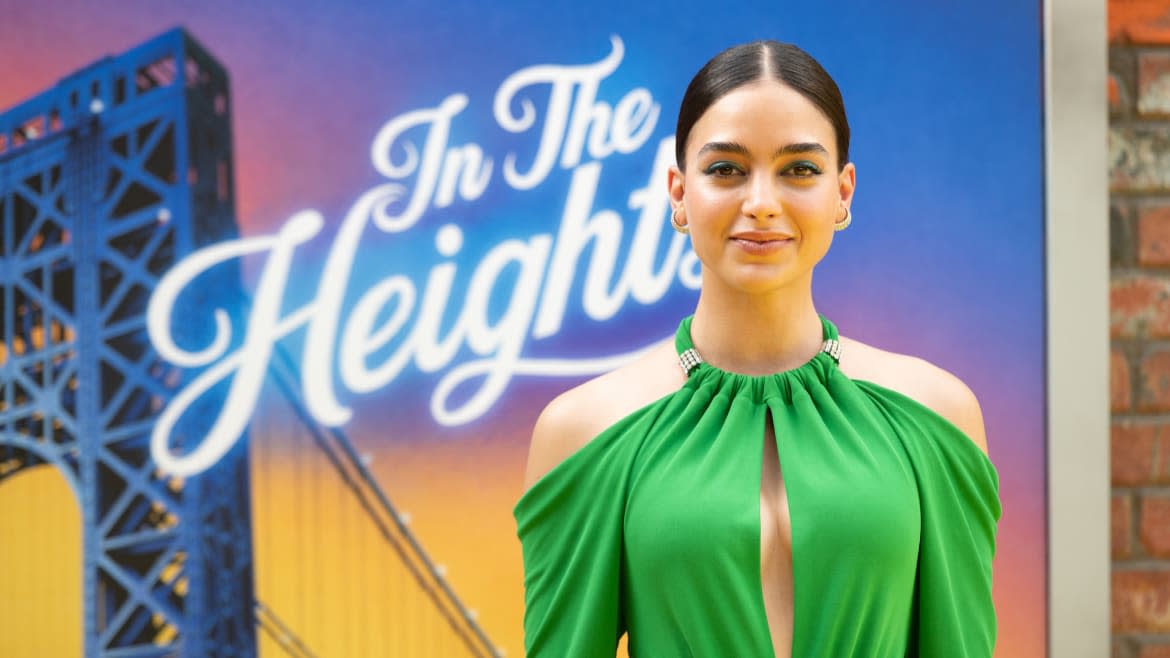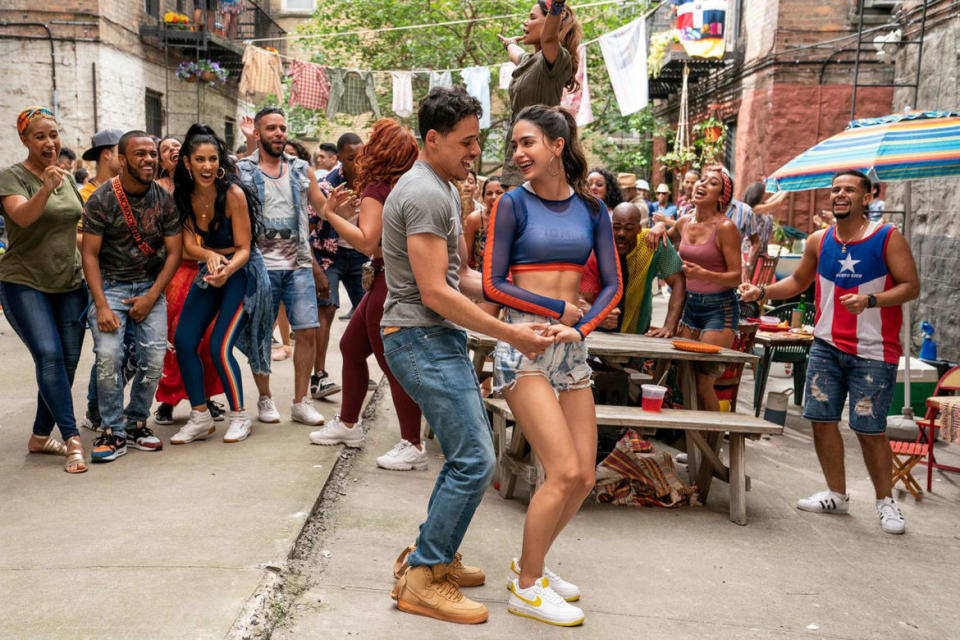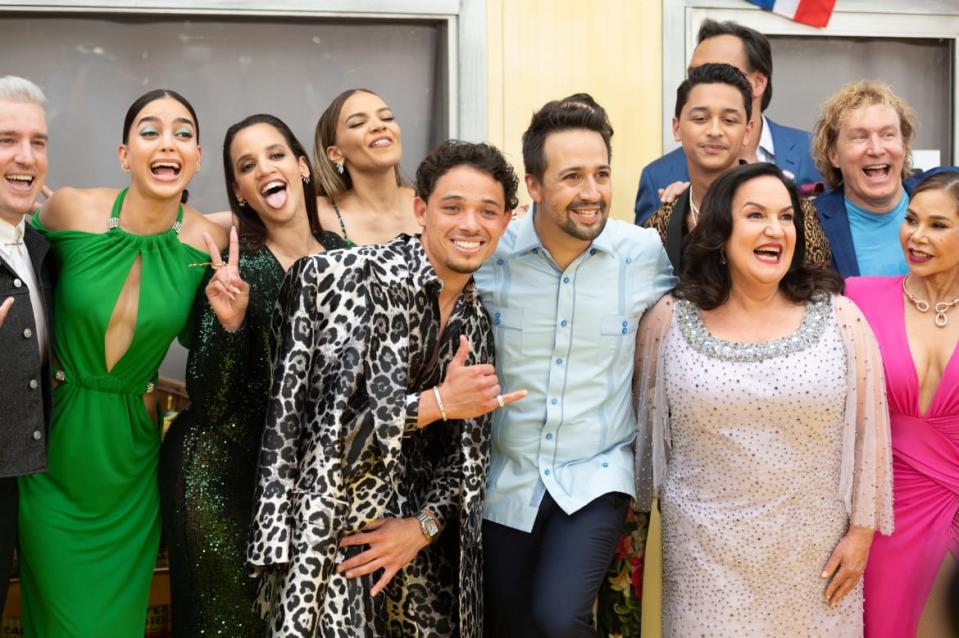‘In the Heights’ Is Just the Beginning for the Radiant Melissa Barrera

The riotous musical kaleidoscope of Jon M. Chu’s In the Heights—adapted from Lin-Manuel Miranda’s Tony-winning musical—reflects and refracts a host of connected ideas: joy, love, and out-and-loud Latinx pride chief among them. It’s a loving snapshot of New York City’s working-class Puerto Rican, Dominican, Cuban, Mexican, and other Latinx communities, handled with uncommon care and affection.
It’s a common refrain by now in discussions of the film, for good reason: There has just never been a movie like In the Heights before.
It looks authentically the part, for starters, with costumes pulled straight from the sidewalks of the city in the summer: distressed jeans, tanks printed with the Puerto Rican flag, crop tops and bare shoulders and sneakers galore. Places that New York-centric movies have traditionally ignored—a taxi dispatch center, a Latina-run beauty salon, the community swimming pool—transform into places full of romance, even magic, through Chu’s lens. More, In the Heights defies U.S. media’s monolithic view of Latinidad. It includes a spectrum of characters, white, Black, and brown alike, from first- to fifth-generation Americans, some with differing immigration statuses, others with stories that have nothing to do with immigration at all.
The Dazzling ‘In the Heights’ May Be the Best Movie Musical in Decades
There’s plenty left out of the picture—no one film could possibly capture the universe of experiences across the diaspora. The movie could have gone harder on oppressive forces both outside and within the community. The specter of gentrification haunts only the edges of the film, redirecting characters’ lives but never dampening the party. And important, nuanced storylines about racism within Latinx communities, present in Miranda’s Broadway version, disappear on the big screen.
Still, the release of In the Heights in theaters and on HBO Max this weekend is a watershed moment. Latinxs have proven for decades that they are some of the most reliable movie-goers in the U.S., buying opening-weekend tickets in numbers massively disproportionate to their representation onscreen. Now, for the first time, a big-budget musical blockbuster centers around some of our communities. There has never been anything like it on this grand a scale.
For Melissa Barrera, In the Heights is a breakthrough moment of a different, more personal kind, too. She plays Vanessa, an aspiring fashion designer, the girl-next-door every guy at the club wants to dance with, and bodega owner Usnavi’s (Anthony Ramos) lifelong crush. It’s Barrera’s first big starring role in an American film after a revelatory run in Starz’s undersung drama Vida—the Latina-led and -created series that introduced her to Hollywood after years spent working in Mexican telenovelas. She’s a native of Monterrey in Mexico’s Nuevo León, and you’re going to see a lot of her on the big screen in the next few years.

Anthony Ramos and Melissa Barrera in In the Heights
Vanessa’s story mirrors and intertwines with Usnavi’s in ways that reflect the diversity of Latinx experiences in the U.S.: where Usnavi is desperate to one day return to his childhood home in the Dominican Republic, Vanessa is driven to make it into the center of New York’s fashion world downtown. Between the dazzling dance numbers and dreamlike romance, their stories focus on one of few common strains of the immigrant experience: feeling drawn to both here and there, negotiating dual pulls.
There is home, wherever and whatever that may mean—family, tradition, a faraway island, a tight-knit city block—and there is the unknown toward which so many must push for the sake of a dream, a better life, or a way to make good on what we owe our families for their sacrifices.
Barrera is familiar with the conflicting forces. “I feel that all the time,” she says. The now 30-year-old left home as a teenager to study musical theater at New York University, then returned to work in theater and the production boot camps of telenovelas, and has been acting in the U.S. for four years now. “I miss home. I miss my family,” she goes on. “I miss the simplicity of life in Mexico, honestly. And I also get reminded a lot on social media that I’m Mexican. Whenever I post something in English or about my work in the United States, there’s always someone that reminds me—in not nice ways sometimes. They’re like, ‘Oh, have you forgotten how to speak Spanish? Did you forget you’re from Mexico?’”
But it isn’t Vanessa’s story she relates to the most in In the Heights—it’s Nina’s, the second-gen American (played by a powerhouse Leslie Grace) whose admission to Stanford has made her the pride of her neighborhood. Nina is “the one who made it out,” as she sings in the stunning number “Breathe.” But she can’t bring herself to tell anyone how out of place she feels at school, how she’s been made to feel like she doesn’t belong, to the point of dropping out. Barrera has spent the last decade-plus navigating shifts in the way she’s perceived at home versus here in the U.S. Like it was for Nina, the difference could be dehumanizing.
“Orientation week at NYU, I was asked to go to a reunion for students of color. And I was like…” she trails off, eyes wide at the memory. “I was so confused. It was a culture shock for me. I grew up a Mexican among Mexicans. I was never otherized, I was never put in a box or anything like that.” She was one of three or four international students in the school’s Theater Studies program and the only Latina. “I was tokenized in a way that, at the time, I didn’t realize was a little bit offensive. When people were like, ‘Oh my god, your eyebrows, they’re like Frida’s! Oh my god, your accent—say that again! Say your last name!’ And they would talk to me pretending to do a Latino accent.”
At the time, she thought, it was all in good fun. “I kind of enjoyed the attention, in a weird way,” she remembers. Now in retrospect, she recognizes how isolating the experience was. “People wanted to be friends with me because I was Mexican—because I was like, the exotic one. But I think because of that, I had a really hard time connecting with people,” she says. “I felt like the intention behind it was not because they liked me as a person, but because they were curious about me.” She didn’t have any friends that first year of college, spending evenings Skyping a friend from back home instead. “And then I went back to Mexico and I kind of forgot.”
When she moved to the U.S. again at 26, it was to Los Angeles, where trailblazer Tanya Saracho’s Vida took place. It was a time of friction and change: Donald Trump had been elected president, and the #MeToo movement was sweeping Hollywood. It changed the way Barrera let others speak to her. “I dealt with a lot of microaggressions in the form of jokes where people would be like, ‘Oh, did you just move here? Did you jump over the wall?’” It happened in audition rooms, at the gym, at parties. She no longer laughed along for the sake of keeping the peace. “You ask, ‘I don’t find that funny, why is that funny?’ And then they realize what they said was actually racist or insulting.”
Barrera credits her time on Vida for first opening her eyes to both social-justice issues for Latinxs in the U.S. and issues of colorism and racism in Mexico as well. “I feel like I’ve been educated,” she says. “I’ve become more conscious of the way that I talk. Things that have been so deeply ingrained that I don’t even notice, when I’m being misogynistic myself or when I’m being racist. It’s a daily learning experience.” That extends to within her own home, too, “even with my husband,” the musician Paco Zazueta, whom Barrera wed in 2019. “He’s a northern Mexican, which is like a very macho territory. So it’s a daily, conscious effort to educate ourselves and to change the way that we talk.”
Her experiences on both sides of the U.S.-Mexico border helped inform Barrera’s understanding of In the Heights’ characters. Her musical theater background came in more than handy, too. But what one number in particular—“The Club”—required of her, she feared, might be more than she could deliver. In the furious-paced number, Vanessa and Usnavi fail to connect in a salsa club; each has their eyes trained on the other, yet neither has the gall to be straightforward. As Vanessa, Barrera becomes the light of the room, spinning, twirling, and teasing her way through choreography that turns her face into a hair-whipped blur.
“That was me,” she assures me. “Yeah, no, that was all me.” She’s pained that the final product left any room for doubt. “The choreography is so fast and my hair is in my face so much that when I saw it, I was like, damn it! Whyyy?” she groans.

Melissa Barrera, Dascha Polanco, Anthony Ramos, Leslie Grace, Lin-Manuel Miranda and Daphne Rubin-Vega attend the opening night premiere of In The Heights during 2021 Tribeca Festival at United Palace Theater on June 09, 2021, in New York City.
“It took me a lot to learn that choreography,” she says, calling it by far the hardest part of making the film. “I knew there was a big number and that Vanessa’s the focus. And if she’s the girl that everyone wants to dance with, it’s because she’s a really good dancer. And I am not a great salsa dancer. So I had to really drill that choreography.”
The cast had 10 weeks of rehearsals to prepare for filming all of the musical’s numbers; Barrera estimates she spent eight of those weeks working on just “The Club,” constantly “excusing myself from other choreography and being like, I got this one, can I go practice ‘The Club?’” Choreographer Eddie Torres Jr. guided the cast through the film’s Latin dance styles. Still, “There were points where I was like, I’m not going to be able to do it,” Barrera says. “But I didn’t want to use a dance double. I feel like I can tell when it’s a dance double.”
They spent two days, in the end, shooting the club sequence. “After those two days, I don’t think I’ve ever been prouder of myself,” she says. “I felt like I had made it to the top of Mount Everest. And if I conquered that, I could do anything. It was very empowering.”
In the film, what unites Washington Heights’ diverse cast of characters is all of their pursuits of a sueñito, a little dream. Vanessa’s is to make it in the world of fashion. And Barrera’s, meanwhile, is to one day own her own production company “creating content for TV and film that continues to tell Latinx stories in different ways and give opportunities to other talents that are coming up,” she says. “Because I’ve been lucky that I’ve been given opportunities in my career by people that have believed in me. And I want to do that for more people in the community.”
“I’ve come to know, since I’ve moved to the U.S., the value of telling stories like In the Heights,” she says, in which Latinx, immigrant, and other communities of color can see reflections of the specific struggles that touch so many of our lives. “People who watch the movie are going to feel less alone in their journeys. I feel like it’s a beautiful thing to be able to tell stories like this, that haven’t been told in this major, global way before.”
For her—and for us—it’s just the beginning.
Get our top stories in your inbox every day. Sign up now!
Daily Beast Membership: Beast Inside goes deeper on the stories that matter to you. Learn more.

 Yahoo Movies
Yahoo Movies 
